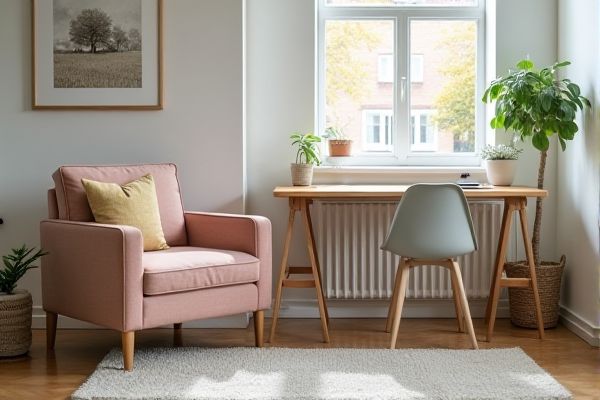
Accent chairs add style and comfort to any room, serving as decorative focal points with plush cushioning and unique designs, while desk chairs prioritize ergonomics and support for extended periods of sitting, enhancing productivity at your workspace. Explore the rest of this article to discover which chair best suits your needs and enhances your environment.
Table of Comparison
| Feature | Accent Chair | Desk Chair |
|---|---|---|
| Purpose | Decorative seating, style enhancement | Ergonomic support for work, desk tasks |
| Design | Stylish, varied shapes, fabric/vintage options | Adjustable height, swivel, lumbar support |
| Comfort | Moderate padding, for short-term sitting | High comfort, designed for prolonged use |
| Mobility | Stationary, generally no wheels | Often includes casters for easy movement |
| Adjustability | Fixed structure, minimal adjustability | Adjustable height, tilt, armrests |
| Use Cases | Living rooms, lounges, accent corners | Offices, home workstations, study areas |
| Price Range | Varies; often mid-range to high for design | Wide range; budget to premium ergonomic models |
| Material | Fabric, leather, wood, metal | Mesh, leather, plastic, metal frame |
Introduction to Accent Chairs and Desk Chairs
Accent chairs are designed to enhance interior decor with stylish, comfortable seating often featuring unique shapes and materials, making them ideal for living rooms and lounges. Desk chairs prioritize ergonomics and adjustability to support prolonged sitting during work, offering features like lumbar support, swivel capabilities, and height adjustments. Both types serve distinct purposes: accent chairs combine aesthetics and comfort, while desk chairs focus on functionality and posture support in office environments.
Key Differences Between Accent Chairs and Desk Chairs
Accent chairs prioritize style and aesthetics, designed with unique shapes, colors, and materials to complement living spaces, while desk chairs emphasize ergonomic support, adjustable features, and mobility for long hours at a workstation. Desk chairs often include lumbar support, swivel capabilities, and height adjustment to enhance comfort during tasks, whereas accent chairs focus on visual appeal and occasional seating function without specialized ergonomics. Material choices also differ, with desk chairs commonly featuring breathable mesh or leather for durability and comfort, compared to the plush fabrics and decorative patterns typical of accent chairs.
Purpose and Functionality Compared
Accent chairs primarily serve decorative purposes, enhancing the aesthetic appeal of living spaces with unique designs and comfortable seating. Desk chairs are engineered for ergonomic support during extended periods of work, featuring adjustable height, lumbar support, and swivel capabilities to improve productivity and reduce strain. Understanding the distinct purposes helps you choose the right chair to complement your space while meeting functional needs effectively.
Design and Aesthetic Appeal
Accent chairs showcase bold designs and vibrant colors that enhance your room's aesthetic appeal, serving as a stylish focal point in living spaces. Desk chairs prioritize ergonomic design and adjustable features to support long hours of work, often featuring neutral tones that blend seamlessly with office decor. Balancing style and comfort depends on your need for visual impact versus functional support in your environment.
Comfort and Ergonomics
Accent chairs prioritize style and moderate comfort, often featuring plush cushions and supportive padding ideal for short-term seating but lacking advanced ergonomic features. Desk chairs are designed with adjustable height, lumbar support, and swivel capabilities to promote proper posture and reduce strain during extended periods of work. Choosing the right chair for your workspace ensures optimal comfort and ergonomic benefits tailored to your daily activity needs.
Material and Build Quality
Accent chairs often feature stylish upholstery materials like velvet, leather, or linen combined with wooden or metal frames, prioritizing aesthetic appeal and comfort in living spaces. Desk chairs typically use durable mesh or leatherette materials designed for breathability and long hours of use, supported by ergonomic builds with adjustable components to enhance posture. Your choice depends on whether you prioritize the visual texture and design of an accent chair or the functional, sturdy construction of a desk chair for daily work tasks.
Space and Placement Considerations
Accent chairs typically serve decorative purposes and require more flexible placement options, often positioned in living rooms or lounges to complement existing furniture without demanding proximity to a work surface. Desk chairs are designed for ergonomic use at workstations, necessitating precise placement near desks with sufficient space for reclining and movement to support productivity. Considering room size and spatial layout is crucial; accent chairs thrive in open areas enhancing aesthetic appeal, while desk chairs need efficient placement to optimize functionality in home offices or study spaces.
Cost and Affordability
Accent chairs generally offer a more affordable range compared to desk chairs, with prices starting as low as $50, suitable for budget-conscious buyers seeking style and comfort. Desk chairs, often designed with ergonomic features for prolonged use, typically cost between $100 and $500, reflecting their investment in health and productivity. For individuals prioritizing budget over specialized function, accent chairs provide cost-effective seating options, whereas those requiring daily support and adjustable settings may find the higher cost of desk chairs justified.
Pros and Cons of Accent Chairs vs Desk Chairs
Accent chairs offer stylish design and comfort ideal for living areas, enhancing room aesthetics but often lack ergonomic support needed for prolonged sitting. Desk chairs provide adjustable features like lumbar support and swivel capabilities, optimizing posture and productivity during work hours but may appear less decorative in casual settings. Your choice depends on balancing comfort, functionality, and visual appeal based on the primary use of the chair.
Which Chair is Right for You?
Choosing the right chair depends on your specific needs and environment. Accent chairs offer style and comfort for relaxation areas, enhancing room aesthetics, while desk chairs prioritize ergonomics with adjustable features for prolonged work sessions. Your decision should balance comfort, functionality, and the primary use to ensure optimal support and ambiance.
 homyna.com
homyna.com